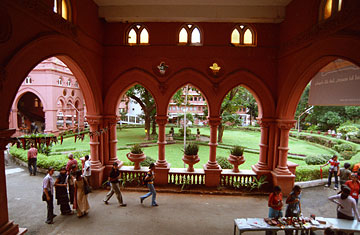
Students at Sophia College in Mumbai, India
For decades, foreign universities have been an integral part of India's higher education. Whiz kids across the country with the financial means have left for highly regarded global universities to study. Many never return, taking both their tuition money and their talent overseas. More than 160,000 students are currently studying in schools in the U.S., Australia, Britain and elsewhere. Over 100,000 pack up and head to study abroad every year, spending $7 billion on tuition and housing.
But what if big foreign universities like Yale, MIT, Stanford, Columbia Business School and the London School of Economics could set up campus in India? India's new Minister for Human Resource Development, Kapil Sibal, wants to make that happen. Sibal intends to have new laws in place by next July that would open up India's heavily regulated educational system to foreign players, with a goal of building a skilled pool of local managers and workers to help run an economy that continues to grow at a rate of 6.7%. Sibal also intends to make this new wave of higher education accessible to a larger swath of students, having foreign schools reserve over a quarter of their seats for India's economically disadvantaged. "If India wants to be a world-class educational hub, then we need access to global institutions," said Sibal early in July.
Sibal is not alone in his mission. On July 6, Finance Minister Pranab Mukherjee increased the budget for higher education by 55% to $3.1 billion, saying that "the demographic advantage that India has needs to be converted into a dynamic economic advantage by providing the right education and skills." Taking cues from India's politicians, nearly all of the major foreign English-language universities now have an eye on India. Next January, Allan Goodman, president and CEO of the New York–based Institute of International Education (IIE), with which some 800 U.S. colleges are affiliated, plans to take a 20-college delegation to India to explore opportunities to set up programs there. Goodman sees India's large English-speaking population, affluent middle class and the value given to higher education as attractive opportunities for his schools. "For us, India is the country of the future," says Goodman.
While many foreign universities already have Indian partnerships in place, their models of business vary. Carnegie Mellon, for instance, has for the past eight years offered a master's program at the Chennai-based Sri Sivasubramaniya Nadar School of Advanced Software Engineering. Students fork over $53,000 for the 18-month program — 15% lower than if the coursework were done in the U.S. They also spend the last six months at Carnegie Mellon's Pittsburgh campus. The London School of Economics offers three-year undergrad degrees in economics, finance and management through the Indian School of Business and Finance (ISBF) in New Delhi, for a total tuition of $20,000, or one-fifth the standard cost. "Our students get a degree from a reputed foreign university at Indian rates, while LSE gets global reach," says ISBF director Jitin Chadha.
Tie-ups like these may be a bargain, but they also circumnavigate national requirements for accredited schools, which govern student admission, fees and faculty salaries. Carnegie Mellon, for instance, now selects students jointly with its private Indian counterpart, and sets its own curriculum that is taught by local faculty. Under the proposed legislation, schools would continue to operate with those special concessions. But Sibal plans to make it mandatory for foreign universities to reserve seats for the underprivileged — a requirement that has not gone down well with many academicians. "If a country's aim is to educate the poor, then many foreign universities are not going to do that because [those students will] survive on grants and not fees," says the IIE's Goodman.
India needs to find a way to boost its higher-education sector. A 2006 McKinsey study concluded that only 25% of India-trained engineers and 15% of finance and accounting professionals had the skill sets to work for multinational companies. The report highlighted the dismal quality of education in many private colleges, where the curriculum is not in sync with industry needs. And this unemployable workforce is growing: India has the world's largest pool of young people, with nearly 60% of its population under 25, according to the National Knowledge Commission, a government advisory body on higher education. Of these, relatively few go to college. Currently, only 11% of those aged 17 to 23 sign up for higher education. Prime Minister Manmohan Singh wants to double the college-going rate in the next five years, and wants more Indian institutes for technology and management.
Sibal's legislation still needs to be approved by the Indian Parliament. And the government still needs to ease regulatory roadblocks and find a way to make education a financially viable business for all concerned. But if that can be done, many more Indian students may just stay at home to study.
Download the new TIME BlackBerry app at app.time.com.
